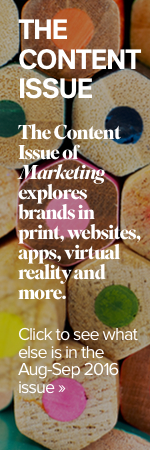Should brands sell advertising on their content platforms?
Share

If brands are media platforms, can their owned platforms be subsidised by selling third-party advertising? We ask Sally Wright her thoughts.
This article originally appeared in The Content Issue, our August/September 2016 issue of Marketing mag.
Taking the ‘brands are publishers’ philosophy to its conclusion, branded content stands on its own. Whatever format and genre a piece of content takes, and whether it provides value as entertainment or utility, it’s seeking an audience. The audience a content marketing program attracts is likely valuable to other brands.
Can a brand creating a magazine, website, app or other content open it up to third-party advertising? The answer, of course, is that it depends.
It’s not just a numbers game
 As with any media property, the suitability of a particular platform as an advertising platform depends on reach, frequency, suitability of the environment for third parties and the value of the audience.
As with any media property, the suitability of a particular platform as an advertising platform depends on reach, frequency, suitability of the environment for third parties and the value of the audience.
If you’re a media buyer, why would you invest in a branded publication? Well, for starters, reach. “Brand publishers combine targeted audiences with mass reach,” says Sally Wright, executive general manager and cofounder of Medium Rare Content Agency.
“For example, David Jones’ new magazine has a guaranteed circulation of 250,000, which dwarfs the reach of comparative consumer titles. Foxtel’s readership of 850,000 makes it the number one entertainment title. Qantas magazine reaches 2.3 million passengers and the Travel Insider website attracts a million page impressions every month.
“But reach is not the sole attraction. These brands speak to hard-to-reach audiences who, the metrics show, are highly engaged. They are iconic brands distributing premium content, for which association in itself is beneficial. And they offer opportunities to speak to loyal customers at every stage of the purchase path – from inspiration right through to the in-store or online sale.”
If you add to that the audience data and email lists of loyalty programs, brands like David Jones, Coles and Qantas become some of the strongest advertising properties in the country.
Will ads support or detract?
A brand publisher has concerns beyond reach, frequency and audience. What’s possible is not often what’s right. The key question is whether ads will support or detract from the purpose of producing content in the first place.
“Content and advertising are both designed to inspire action. But whereas advertising pushes messages, content pulls the audiences in by addressing their direct needs through areas of expertise,” Wright says. “Content marketing allows brands to become part of their customers’ daily lives. Content has perceived value and therefore builds goodwill.
“Opening your brand channels to third-party advertising can maximise your return on investment and help fund your content programs. But your marketing goals must remain paramount. If advertising is going to dilute your messaging or compromise your hard-earned customer relationships, then it is not recommended.”
Choosing partners
If advertising is allowed, the publisher brand is invariably choosy about who it lets onto its property, and for good reason. The general question is what effect the association with a third-party brand will have on the brand that owns the content.
“When the inclusion of advertising positions the brand with like brands, it can send a message that you’re in good company,” Wright says.
Often the question becomes whether the relationship between a brand and its suppliers lends itself to this kind of arrangement.
“Where it works really well is when the brand and the advertisers have a common goal. A really good example is a retailer, because it has the same success metric as its suppliers: to drive sales.”
But what about non-retail situations? For brands such as Qantas, Wright says that advertising works best when the third-party brand fuses with the DNA of the host platforms.
Going native really works
Display ads are one thing, but advertising works even better when created by the team that knows the audience best, Wright says. “Native advertising lends itself particularly well to brand channels. Creating bespoke content with the audience in mind can generate a win-win-win for the advertiser, customer and host brand.”
For Coles, most of the native content created are recipes, which add value for the customer. They are based on the same insights and analytics used for Coles’ recipes, which benefits the advertiser. And Coles gains more than revenue: it gets additional content to engage its audience and, ultimately, drive product sales.
For Qantas, says Wright, “travel-based content is an obvious winner, whether for state-based tourism bodies or for clients such as Tiffany, for which we created a special co-branded ‘New York Minute’ execution, which seamlessly linked Tiffany watches to the ultimate insider’s guide to the Big Apple.
“Typically, a native content execution on Qantas channels will include amplification through EDMs, Outbrain and Facebook, retargeting through Red Planet and driving conversion through social.
“For tourism bodies, we can even look to provide the native content for their own content marketing initiatives.”
Progressive brands invest in content
The types of brands investing in content is diversifying – digital-native company Airbnb has a magazine, Snapchat has now launched an online magazine: the need to make sure content is done really well grows. “It’s interesting how the more progressive brands are embracing content and being very sensible about it,” Wright says. “They’re not overinvesting; they see it as part of their overall mix, tying in with all their media. Content is part of a seamless message going out to the audience.”
–
This article was originally published in The Content Issue and was made possible thanks to Issue Partner Medium Rare Content Agency















